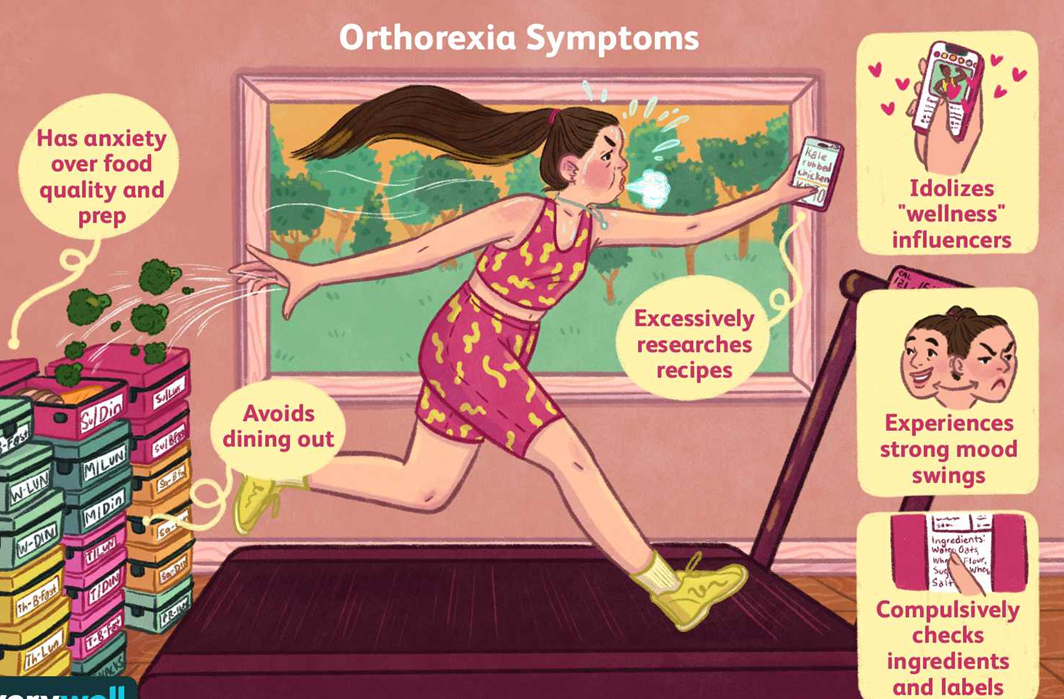A nurse is caring for a client who reports that they have been eliminating specific foods from their diet in order to “eat clean.” The nurse should identify that this is an indication of which of the following conditions?
Anorexia nervosa
Rumination disorder
Orthorexia
The Correct Answer is C
Choice A Reason: Anorexia Nervosa
Anorexia nervosa is an eating disorder characterized by an intense fear of gaining weight and a distorted body image, leading to restricted food intake and excessive weight loss. Individuals with anorexia nervosa often have a relentless pursuit of thinness and may engage in extreme dieting, excessive exercise, and other behaviors to lose weight. While eliminating specific foods can be a part of anorexia nervosa, the primary focus is on weight loss and body image rather than the purity or healthiness of the food.
Choice B Reason: Rumination Disorder
Rumination disorder involves the repeated regurgitation of food, which may be re-chewed, re-swallowed, or spit out. This condition is more common in infants and individuals with developmental disabilities but can occur in people of all ages. The behavior is typically involuntary and not related to concerns about food purity or healthiness. Therefore, it does not align with the client’s report of eliminating specific foods to “eat clean.”
Choice C Reason: Orthorexia
Orthorexia is an eating disorder characterized by an obsession with eating foods that one considers healthy or pure. Individuals with orthorexia may eliminate entire food groups, such as sugars, carbohydrates, or dairy, in their quest to maintain a “clean” diet6. This condition can lead to malnutrition and social isolation due to the restrictive nature of the diet. The client’s report of eliminating specific foods to “eat clean” is a clear indication of orthorexia.

Nursing Test Bank
Naxlex Comprehensive Predictor Exams
Related Questions
Correct Answer is C
Explanation
Choice A Reason:
Emotional injury and learned helplessness. While emotional injury and learned helplessness are significant consequences of intimate partner violence (IPV), they are not the central factors driving the dynamic of IPV. Learned helplessness refers to a state where the victim feels powerless to change their situation due to repeated exposure to traumatic events. Emotional injury is a result of the abuse but not a driving factor.
Choice B Reason:
Poor communication and social isolation. Poor communication and social isolation can exacerbate the situation but are not the primary factors central to the dynamic of IPV. Social isolation is often a tactic used by abusers to control their victims, but it is a consequence rather than a cause. Poor communication can contribute to misunderstandings and conflicts but is not the root cause of IPV.
Choice C Reason:
Power and control. This statement is correct. The central dynamic of intimate partner violence is the abuser’s desire to exert power and control over their partner. This need for dominance manifests through various abusive behaviors, including physical, emotional, psychological, and financial abuse. The Power and Control Wheel, a tool developed by the Domestic Abuse Intervention Project, illustrates how different abusive tactics are used to maintain control over the victim.
Choice D Reason:
Erratic relationships and vulnerability. Erratic relationships and vulnerability are characteristics often seen in IPV situations but are not central to the dynamic. Vulnerability can make individuals more susceptible to abuse, and erratic relationships can be a symptom of the abuse, but they do not drive the abusive behavior5.
Correct Answer is D
Explanation
Choice A Reason: Anchovies
Anchovies are a type of small, oily fish that are often used in various dishes for their strong flavor. They are rich in omega-3 fatty acids and other nutrients. However, there is no known interaction between anchovies and disulfiram. Disulfiram specifically interacts with alcohol and alcohol-containing products, causing unpleasant reactions. Therefore, anchovies are not a food item that needs to be avoided while taking disulfiram.
Choice B Reason: Spinach
Spinach is a leafy green vegetable that is high in vitamins, minerals, and antioxidants. It is generally considered a healthy food and does not have any known interactions with disulfiram. Patients taking disulfiram do not need to avoid spinach as it does not contain alcohol or any substances that would cause a reaction with the medication.
Choice C Reason: Grapefruit Juice
Grapefruit juice is known to interact with various medications by affecting the enzymes that metabolize these drugs in the liver. However, there is no specific interaction between grapefruit juice and disulfiram. While grapefruit juice can affect the metabolism of certain medications, it does not cause the same type of reaction that alcohol does when taken with disulfiram. Therefore, it is not necessary for patients on disulfiram to avoid grapefruit juice.
Choice D Reason: Alcoholic Beverages
Alcoholic beverages are the primary substance that must be avoided while taking disulfiram. Disulfiram works by inhibiting the enzyme acetaldehyde dehydrogenase, which is involved in metabolizing alcohol. When alcohol is consumed, acetaldehyde accumulates in the body, leading to unpleasant symptoms such as nausea, vomiting, headache, and flushing. This reaction is intended to deter individuals from drinking alcohol. Therefore, it is crucial for patients taking disulfiram to avoid all forms of alcohol, including alcoholic beverages, to prevent these adverse reactions.

Whether you are a student looking to ace your exams or a practicing nurse seeking to enhance your expertise , our nursing education contents will empower you with the confidence and competence to make a difference in the lives of patients and become a respected leader in the healthcare field.
Visit Naxlex, invest in your future and unlock endless possibilities with our unparalleled nursing education contents today
Report Wrong Answer on the Current Question
Do you disagree with the answer? If yes, what is your expected answer? Explain.
Kindly be descriptive with the issue you are facing.
